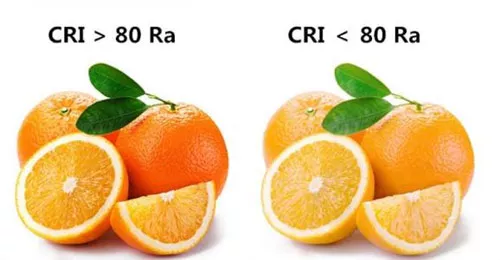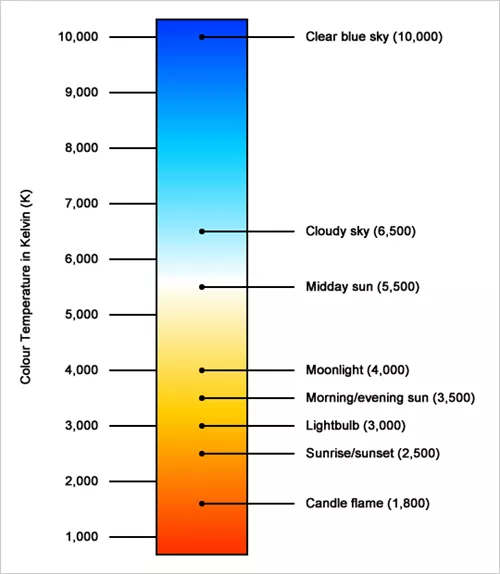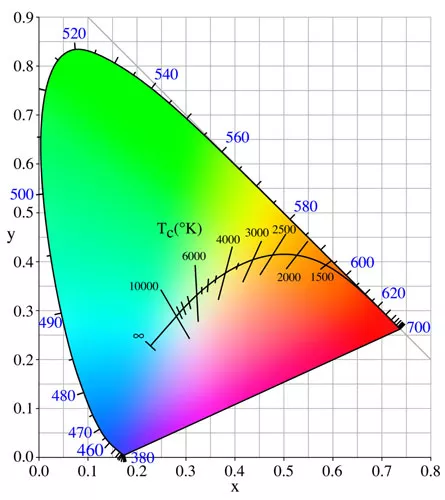12 Tips to Select the Best Outdoor LED Flood Lights and Manufacturers
184812 Tips to Select the Best Outdoor LED Flood Lights and Manufacturers
View detailsUnderstanding these technical terms will help you understand the issues related to the quality of the light offered by LED devices, CFLs and Bulbs and decide if you really should pay a premium for a better Color Rendering Index (CRI) product.
Good quality light is made up of different colors of light. The multi colored rainbow is seen when light is split by small water drops acting as prisms. “VIBGYOR” is a short version of the different colors constituting white light. You can create your own rainbow by using a compact disc. When you hold a CD towards light the prismatic layer of the CD breaks up light into its constituent colors and you can see all the colors constituting light.
Violet, Indigo, Blue, Green, Yellow, Orange and Red are the visible colors of light. Red is the least energetic and violet light is the most energetic of the lot. A spectrum also contains invisible light. As their names suggest – Infra Red light comes before red light and Ultra Violet comes after violet.
A good source of light like LED bulbs produces full spectrum light i.e., light with all colors. Human beings do not need Infrared or UV lights as they cannot be seen by our eyes. In fact both Infrared and UV light may damage art objects and paintings in your house.
The spectrum of UV, visible and IR light radiation. For lighting purposes it is only the colored portion of the spectrum that is important. IR and UV lights can damage art objects. Besides art objects, UV light also harms the skin. Incandescent bulbs produce 95% of their output in the invisible infrared range making them highly energy inefficient..
LED Street Light, Solar Street Light, High Mast Light, LED Flood Light, Our products CCT>80
White light has all the different light colors in almost equal proportions. When white light strikes an object, most colors of light are absorbed and a few are reflected. The color of an object is determined by the color of light it reflects. It is important that a light source emits light with all the colors of light in it.
If light from a source does not have a particular color of light, objects of that color cannot be seen in their natural colors. This is why sodium lights are so bad at reproducing colors. Sodium light is what is called a narrow spectrum light. It is made of primarily yellow light. When an object of a color other than yellow is placed under sodium lights different shades of yellow are the only color that is reflected and almost every object has a sickly hue. LED products produce natural colors as the light is well balanced and contains an optimum spread of all light colors.
Warm yellow light produced by an incandescent bulb has light of all colors but is slightly poor in green, blue and violet lights. Therefore when green, blue or violet objects are seen under an incandescent bulb’s light the colors are not reproduced faithfully. LED’s by contrast produce a complete, well balanced spectrum of light and natural colors of objects are reproduced.
It is pertinent to note here that the CRI of a light source is comparable across sources that work at the same temperature. LED lighting works at very low temperatures compared to an incandescent bulb. Thus the CRI of 85 under estimates their performance. Plans are afoot to take another look at the CRI standard to reflect the reality of the lighting world.

The Color Rendering Index is a measure of how faithfully light from a source will reproduce colors. Incandescent bulbs have a CRI of 100 – which is taken as a perfect score.
Incandescent light is the light source with the best CRI. It serves an index of 100 because the spectrum provides all wavelengths. An incandescent light bulb can be compared to the sun, the sun is our natural light source having an CRI of 100 too. CFLs normally provide a CRI 80.
That is the single most important reason that CFLs have not been able to replace the incandescent bulb despite heavy promotion. There are CFLs that produce warm light. But to produce a warm light the glass coating of a CFL has to be suitable doped with additives that essentially absorb light in one part of the spectrum and emit light in another part. This further reduces the lighting efficiency of CFLs.
LED products and systems are in a different league altogether. If you look at images produced by a LED projector, the vibrant colors reproduced and its superiority over two centuries old incandescent technology becomes apparent. LED light sources are among other light sources superior in lighting effciency and quality.
If you look at the history of lighting, the first electrical and popular wide-spread lamp has been the incandescent one. Other light sources that followed took advantage of newer technology background as well as other possibilities of producing light. Each light source is different, with advantages as well as disadvantages and it is just natural that older light sources will phase out because others are better than the old technology. LEDs are anyway the best lighting source you can get right now for many applications.
Visual tests have shown that the definition of the CRI needs to be reviewed. Scientists asked observers to rate color schemes, which are used to define the CRI of a lamp, under different light sources. The comparisons of LED with lamps of a higher CRI have been surprising.
The observers had the visual impression that both light sources would be equal in lighting quality, although the LED had per definition a worse CRI. One needs to know that the definition of the CRI has been taken part within the time of the invention of discharge lamps. Regarding the basis of the color rendering index, the testing method is taking into consideration 14 different standardized colors.
But only the first eight colors of the reference color scheme are taken into the calculation of the CRI, surprisingly that are pale pastel colors. Now that standard itself is under scrutiny. There is a debate to change the standards to reflect the reality of today’s lighting technology.
The term color temperature describes the temperature of objects by which they emit light, modeled through the “black body radiator”. When increasing the temperature of a “black body”, it starts to emit visible light in a continuous spectrum. The filament of a 60W incandescent lamp heats up to about 3000°F, as a result the lamp emits light with a color temperature of 3000K. Many of our artificial light sources do not create light by heating up a material until it glows like an incandescent lamps. Instead of creating a continuous spectrum, they generate an assortment of color emission lines. A black body color temperature cannot be directly given to this non-blackbody type of emission, generated by high intensity discharge and fluorescent lamps for example.

For those light sources, a correlated color temperature (CCT) is indicated, based on the black body color temperature. A cool white fluorescent lamp has a CCT of about 5000K. The lamps light spectrum is different from a black body one but has the same temperature.The light color influences the atmosphere in a space. The more cozy the ambiance the warmer the light color (lower color temperature) should be and the more dynamic the scene the cooler the light source (higher color temperature).
The CRI is the most important factor to watch when choosing light sources. How good is the light source representing faces, colors and contrasts? The easier the visual task and perception the lower the CRI can be. The color temperature needs to be watched second, it is supporting the space’s atmosphere.
| Lamp Color Name | Apparent Color Temperature (Kelvin) | Characteristics and Examples | Common Adjectives Used to Describe the Light | Best Location |
|---|---|---|---|---|
| Warm White | 2700-3200K | Similar to incandescent bulb, yellowish light best for accentuating skin tones and color of wooden objects | Friendly, warm, inviting, intimate, relaxing | Homes, boutiques, reception areas, Hotels. |
| Natural White | 4000-4500K | Similar to early morning sunlight, Xenon lamp for automotive use | Neat and clean, Natural tone | Offices, School Lights, Outdoor Areas |
| Day White | 5500-6000K | Typical day light, Flash light. Metal Halide | Crisp light, efficient, brightly lit, natural outdoor | Retail stores, Factories, Printing, Warehouses, Schools, Parking Lots, Outdoor Area Lighting |
| Cool White | 7000-7500K | Best contrast but least flattering to the skin, may need mixing with light from a warm white lamp. | Bright light, bluish light | Special applications needing high light intensity and good color rendition like art Galleries, museums, showcases for precious stones and jewelry |
So how much CRI do you need? It really depends who you are. Are you a retail store like the Gap or Bed Bath and Beyond? Are you a car dealership? Are you a hospital that wants to replace your parking lights? Are you a factory, a warehouse or a school? or for roadway lighting, need solar street light, led street light? Different businesses and facilities all have different needs.
If you are a retail shop selling to consumers, high CRI is good. 80+ is preferred. 85 is great, even 90. If you are a not a retailer, then 70+ will be just fine. But can you visibly see the difference between 70 CRI and 90 CRI. Then answer is yes, if you know what to look for.
At a recently lighting trade fair, we walked into a booth that displayed a series of glass bowls of colorful gumballs. Each bowl was under a LED light, and the CRI of that light was labeled above the bowl. We walked from the 70 CRI display all the way to the 95 CRI bowl and thought to ourselves “We’re not seeing the difference”. So then an engineer walked up to me as we kept on walking from bowl to bowl and he told me to “Look at the red gumballs”. And sure enough, the red gumballs became brighter and more vibrant as the CRI increased. The other colors seemed similar from one display to the next.
So, as a factory or a warehouse manager, do you care if the reds in your warehouse are not as vibrant under 70 CRI than under a 95 CRI light? Are you prepared to pay more for that difference? Probably not. If you own a clothing store, then you probably want the best quality of light available.
This is many ways is not even a fair fight. Especially when you compare High Pressure Sodium to almost every light source available on the market today. High Pressure Sodium CRI is somewhere between 20 and 40. The color temperature is somewhere around 2300K, so what you have is a very warm (yellow) light that tends to discolor everything.
Did you notice how everything under a HPS light looks yellow? That in fact, is the perfect example of poor CRI. Good CRI makes colors look as they should appear, bad CRI discolors everything.Metal Halide fairs better. Its CRI is much better than HPS, but typically lower than LED. So the light quality of Metal Halide is not as good as LED.
In fact something else happens with Metal Halide bulbs. A brand new Metal Halide bulb is very bright right out of the package, but every one knows it loses it lumens very quickly. Within the first 6 months of use (assuming 12 hours a day), the lumens can drop as much as 20%. By the time the light is 50% though its 15,000 hour life, it can lose as much as 50% of its initial lumens. But what is less known is it appears that Metal Halide loses its CRI effectiveness as lumens depreciate.
So not only is the quantity of light dropping, so is the quality of light. Its a double hit on the amount and usefulness of light. It appears Metal Halide bulbs are like fireworks. Bright to start, but fizzle out quickly.So in the world of HID lighting, not only does it make sense to replace these lights with LED because of the dramatic and significant savings available when you convert over, but the quality of light will also improve.
In summary, the most important thing to remember about CRI is that you should think about the application that the lights are going to be used for. The majority of installations do not need to purchase higher cost high CRI lights. But when the need arises, they are available for those applications that need to make product or colors stand out.
Color Temperature Chart:

The color temperature map reflects the changes in color on the Kelvin color scale caused by changes in degrees Kelvin.
Color temperature charts range from 1000K to 10000K and show values in degrees Kelvin.
Typical color temperature:
1800K – Candlelight
2500K – Sunrise and Sunset
3000K-bulb
3500K – Morning or evening sun
4000K-Moonlight
5500K – Noon Sun
6500K – cloudy sky
10000K – Clear Sky
LED lighting color temperature:
1500K~1800K-candle
1900K~3500K-warm
Some city street road choose it;
3600K~4500K-Natural color; main High Mast Light, LED Flood Light choose it.
4600K-5500K-cool; main LED Streetlight choose it.
5600K~6400K-Cool Daylight
6500K+ – Ultra Daylight
How to choose the right color temperature?
There are various properties to consider when choosing the right color temperature or even RGB color variation. The first factor is the type of space in which you want to place the lighting. Second, you need to identify the main goal of lighting that particular space.
It’s also important to start by assessing the amount of natural light that already exists in the area, what spaces are currently being used, and what ambience you want to create with the illuminance.


Tips to Consider:
Suggestions:
This range communicates directly with a human’s light sensor and can detect the difference between bright sunlight and warm tones, which means the day is coming to an end.
Warm color temperature LED lights prepare the brain for a good night’s sleep. A warm-light bedside reading light is also recommended for nighttime directional reading.
12 Tips to Select the Best Outdoor LED Flood Lights and Manufacturers
View detailsDepth Analysis of LED Street Light Vs HPS Lamp, LED vs HPS Street Lights, Which is Better
View detailsTop 10 Leading LED Street Lighting Manufacturers in the World
View detailsWHAT IS INTEGRATED ALL IN ONE SOLAR STREET LIGHT? and Components
View details
HelloPlease log in